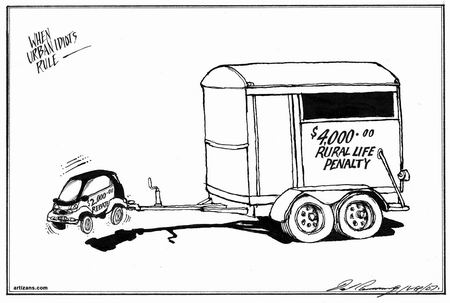What you wanted to known about Green levy on Vehicles
By 250 News

As the editorial cartoon suggests, there are some who view the new Green Fees as a tax on rural life.
The following information was contained in a release made by the Canadian Auto Dealers Association. It sets out the details surrounding the new levies on vehicles announced in the Federal Budget and who qualifies for rebates.
This is a copy of their release.
On Monday March 19th, Finance Minister Jim Flaherty announced details of his second federal budget. CADA was in a special pre-budget lock-up and had the opportunity to review the details Of the budget hours before the Minister spoke in the House of Commons. CADA was able to have one-on-one meetings with the Minister’s senior political staff and senior tax policy officials.
CADA used this opportunity to express first hand the concerns of the auto industry regarding the impact of select budget measures. CADA has also conducted several interviews with major media outlets on the impact of the Budget.
Highlights of the 2007 Budget measures include:
Vehicle Efficiency Incentive (VEI)
The federal government introduced a program that provides rebates to people who buy fuel-efficient or flex fuel vehicles. The government also sponsored initiatives to take old, polluting cars off the road and introduce a green levy on gas guzzlers. The VEI rebate gives up to $2,000 per vehicle to buyers of fuel efficient vehicles. To receive the
rebate, consumers must keep a copy of their lease or sales agreement and demonstrate proof of the vehicle’s registration in Canada. Consumers will send this information to a to-be-established by a government office that will issue a rebate. While vehicles purchased as of March 20, 2007 will be eligible for the rebate, rebates will only be issued once administration systems have been set up, and that is anticipated to be by fall 2007.
• The rebate threshold is based on a combined fuel consumption rating of 55% city fuel Consumption rating and 45% highway fuel consumption rating.
• Cars with a combined fuel consumption rating of 6.5L/100KM, and Trucks/SUV/Minivans with fuel consumption of 8.3 L/100KM or less will be eligible for the rebate.
• The basic rebate amount is $1,000, and increases $500 for each 0.5L/100km improvement in combined fuel consumption rating, to a max of $2,000.
• There will also be a rebate of $1,000 for Fuel Efficient E-85 vehicles
• Rebate eligibility starts on March 20, 2007
Examples of qualifying vehicles and their corresponding rebate include the Toyota Prius ($2000), Honda Civic Hybrid ($2000), Toyota Corrolla ($1,000) Mini Cooper ($1,000), Ford Escape HEV ($2,000), Saturn Vue Hybrid ($1,000), Jeep Patriot ($1,000), Impala Flex Fuel ($1,000), and Sebring Flex Fuel ($1,000).
The full list of eligible vehicles is published on Transport Canada’s Website:
http://www.tc.gc.ca/programs/environment/ecotransport/ecoauto.htm
Green Levy for new fuel-inefficient vehicles
New vehicles, excluding trucks, with fuel–efficiency ratings over 13.0 L/100KM will be charged a New green levy payable by the manufacturer or importer where passenger vehicles are delivered into the Canadian Market. This is also based on the same combination of city (55 percent) and Highway (45 percent) fuel consumption.
The levy will apply to new vehicles delivered by a manufacturer or importer to a dealer after March 19, 2007. Inventories of vehicles held by dealerships will not be subject to the new levy. Certain consumer purchase contracts entered into before March 20, 2007, will also be Grandfathered.
• The new levy starts at $1,000, and increases in increments of $1,000 per full litre Increase in the combined fuel efficiency rating above the 13L. /100Km floor, to a Maximum of $4000.
• Will apply to new vehicles delivered to a purchaser (dealer) after March 19th, 2007. Again Inventories are grandfathered.
• This levy does not apply to trucks, only passenger vehicles. While the definition of “truck” Is not included in the budget documentation, according to the Ministers office – Pick-Up Trucks are not intended to be affected by levy – only SUVs and other larger, fuel Inefficient vehicles.
• Existing excise taxes on heavy vehicles will be eliminated, effective immediately.
• The Minister’s office indicated that the plan was designed to get “the worst of the worst” Off the road – Senior Finance officials indicated that the levy will affect less than 5% of Vehicles sold in Canada.
Getting old cars off the road:
The government responded to a major CADA lobby request to adopt a program to get older Vehicles off the road and provide incentives to purchase newer, cleaner vehicles. The Government will invest $36 million through existing programs to get old vehicles off the road.
Aside from an intention to expand existing programs, no further specifications have been given.
• Federal officials have confirmed that they will have formal consultations with CADA to work on how to make the investment work.
The CADA was quick to point out that collector cars should not be subject to this kind of treatment and they are asking for means to be adopted to protect them
Previous Story - Next Story
Return to Home









